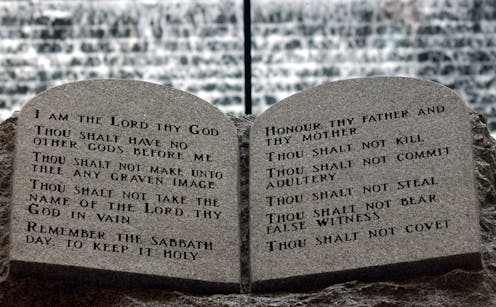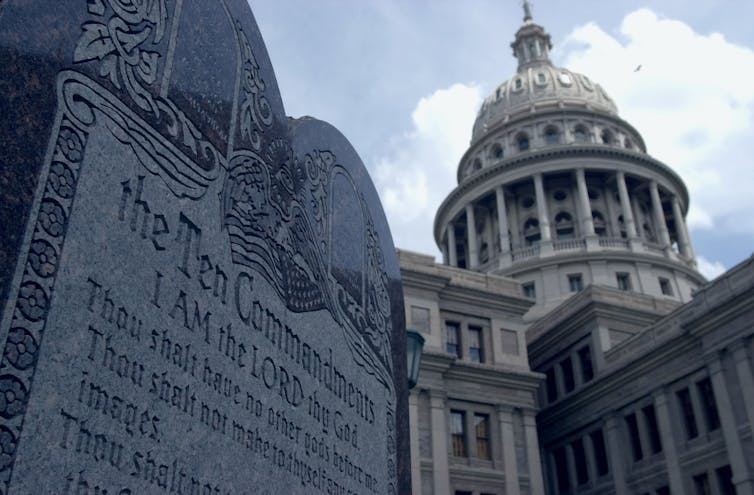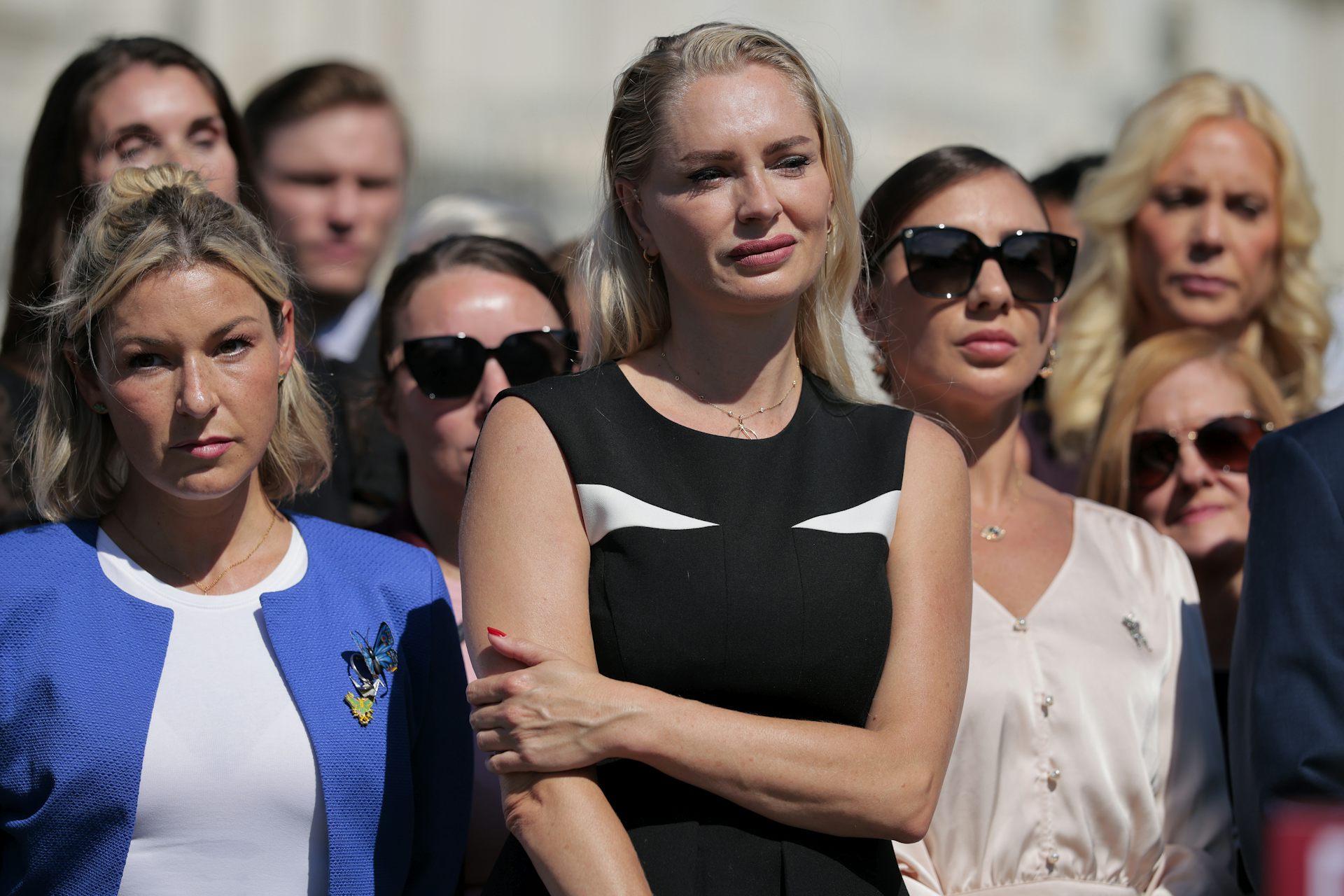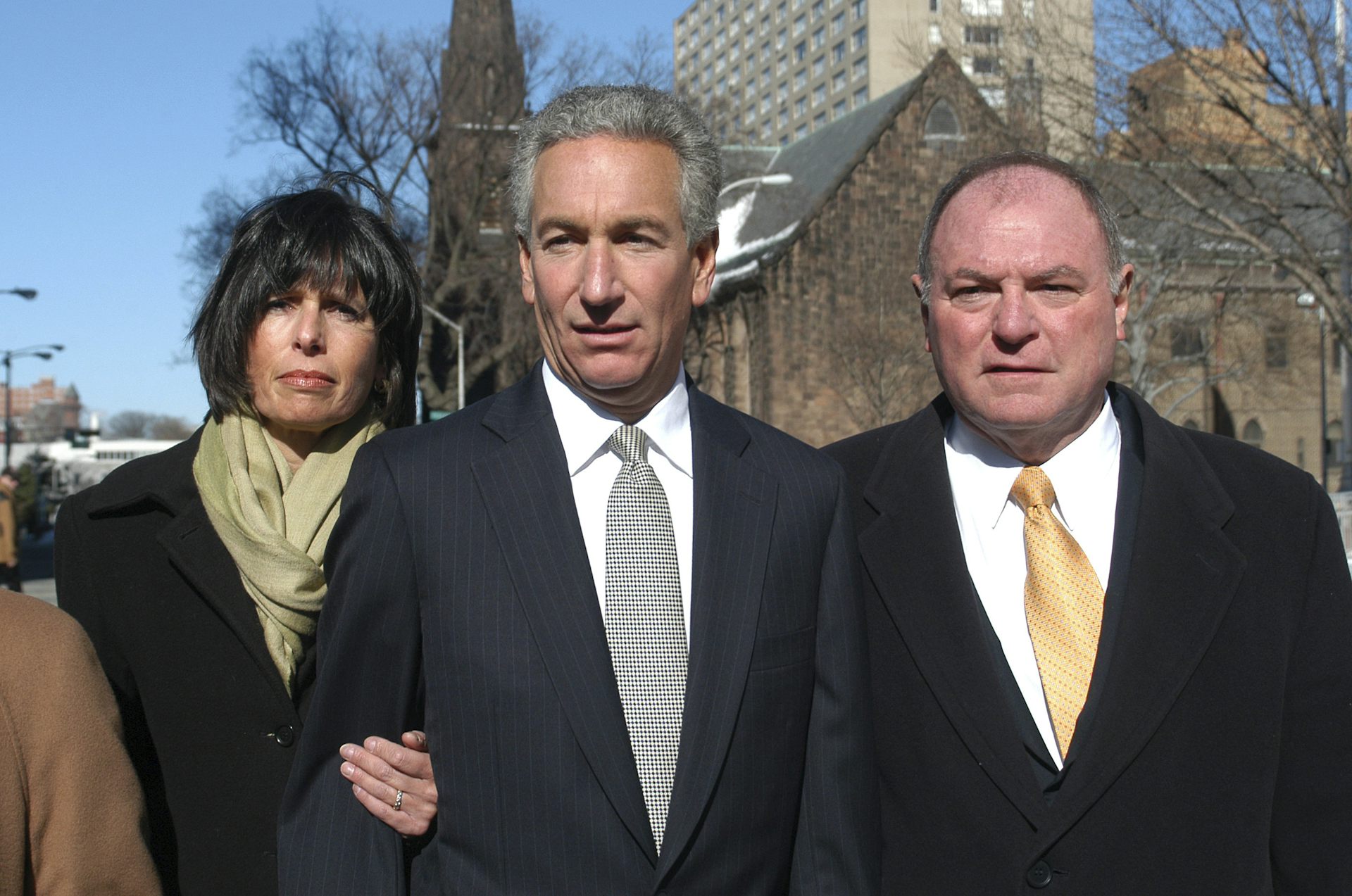Federal judge rules that Louisiana shalt not require public schools to post the Ten Commandments
The Supreme Court’s approach toward religion in schools has been shifting, adding to uncertainty about legislation such as Louisiana’s.

Do the Ten Commandments have a valid place in U.S. classrooms? Louisiana’s Legislature and governor insist the answer is “yes.” But on Nov. 12, 2024, a federal judge said “no.”
U.S. District Judge John W. deGravelles blocked the state’s controversial House Bill 71, which Gov. Jeff Landry had signed into law on June 19, 2024. The measure would have required all schools that receive public funding to post a specific version of the commandments, similar to the King James translation of the Bible used in many, but not all, Protestant churches. It is not the same version used by Catholics or Jews.
Officials were also supposed to post a context statement highlighting the role of the Ten Commandments in American history and could display the Pilgrims’ Mayflower Compact, the Declaration of Independence and the Northwest Ordinance of 1787, a federal enactment to settle the frontier – and the earliest congressional document encouraging the creation of schools.
The law’s defenders argued that its purpose was not only religious, but historical. Judge deGravelles, though, firmly rejected that argument, striking down HB 71 as “unconstitutional on its face and in all applications.” The law had an “overtly religious” purpose, he wrote, in violation of the First Amendment, according to which “Congress shall make no law respecting an establishment of religion, or prohibiting the free exercise thereof.”
Regardless of the Ten Commandments’ impact on civil law, there was a clear religious intent behind Louisiana’s law. During debate over its passage, for example, the bill’s author, state Rep. Dodie Horton said, “I’m not concerned with an atheist. I’m not concerned with a Muslim. I’m concerned with our children looking and seeing what God’s law is.”
Louisiana Attorney General Liz Murrill has said she intends to appeal the judge’s ruling.
As someone who teaches and researches law around religion and education, with an eye toward defending religious freedom, I believe this is an important test case at a time when the Supreme Court’s thinking on religion and public education is becoming more religion-friendly – perhaps the most it has ever been.
How SCOTUS has ruled before
Litigation over the Ten Commandments is not new. More than 40 years ago, in Stone v. Graham, the Supreme Court rejected a Kentucky statute that mandated displays of the Ten Commandments in classrooms.
The court reasoned that the underlying law violated the First Amendment’s establishment clause – “Congress shall make no law respecting an establishment of religion” – because the mandate lacked a secular purpose.
The justices were not persuaded by a small notation on posters that described the Ten Commandments as the “fundamental legal code of Western Civilization and the Common Law of the United States.”
Twenty-five years later, the Supreme Court again took up cases challenging public displays of the Ten Commandments, although not in schools. This time, the justices reached mixed results.
The first arose in Kentucky where officials had erected a county courthouse display of texts including the Ten Commandments, the Magna Carta, the Declaration of Independence and a biblical citation. In a 2005 ruling in McCreary County, Kentucky v. American Civil Liberties Union of Kentucky the five-member majority agreed that the display of the Ten Commandments violated the establishment clause, largely because it lacked a secular legislative purpose.
On the same day, though, the Supreme Court reached the opposite result in Van Orden v. Perry, a case from Texas. The court upheld the constitutionality of a display of the Ten Commandments on the grounds of the state capitol as one of 17 monuments and 21 historical markers commemorating Texas’ history.
Unlike the fairly new display in Kentucky, the one in Texas, which had existed since the early 1960s, was erected using private funds. The court permitted the Ten Commandments to remain because, despite their religious significance, the Texas monument was a more passive display, not posted on the courthouse door.

Louisiana’s law
Louisiana’s law would have required public school officials to display framed copies of the Ten Commandments in all public school classrooms. Posters were supposed to be at least 11-by-14 inches and printed with a large, easily readable font. The legislation would have allowed, but did not require, officials to use state funds to purchase these posters. Displays could also be received as donations or purchased with gifted funds.
The bill’s author, Horton, previously sponsored Louisiana’s law mandating that “In God We Trust” be posted in public school classrooms.
In defending the Ten Commandments proposal, Horton said it honors the country’s origins.
“The Ten Commandments are the basis of all laws in Louisiana,” she told fellow lawmakers, “and given all the junk our children are exposed to in classrooms today, it’s imperative that we put the Ten Commandments back in a prominent position.”
Justifying the bill, Horton pointed to Kennedy v. Bremerton School District, a 2022 Supreme Court decision. Here, the justices held that educational officials could not prevent a football coach from praying on the field at the end of games because he engaged in personal religious observance protected by the First Amendment.
“The landscape has changed,” she said.
New frontier
Indeed it has.
For decades, the Supreme Court used a three-part measure called the Lemon v. Kurtzman test to assess whether a government action violated the establishment clause. Under this test, when a government action or policy intersects with religion, it had to meet three criteria. A policy had to have a secular legislative purpose; its principal or primary effect could neither advance nor inhibit religion; and it could not result in excessive entanglement between state and religious officials.
Another test the Supreme Court sometimes applied, stemming from Lynch v. Donnelly in 1984, invalidated governmental actions appearing to endorse religion.
The majority of the current court, though, abandoned both the Lemon and endorsement tests in Kennedy v. Bremerton. Writing for the court, Justice Neil Gorsuch ruled that “the Establishment Clause must be interpreted by ‘reference to historical practices and understandings.’” He added that the court “long ago abandoned Lemon and its endorsement test offshoot.”
What that new historical practices and understandings standard means remains to be seen.
More than 80 years ago, in West Virginia State Board of Education v. Barnette the Supreme Court decided in a 6-3 opinion that students cannot be compelled to salute the American flag, which includes reciting the words “under God” in the Pledge of Allegiance, if doing so goes against their religious beliefs. While H.B. 71 does not require students to recite the Ten Commandments, they would be constantly exposed to its presence in their classrooms, reducing them to what the judge described as a “captive audience” – violating their parents’ rights to the free exercise of religion.
In 1962’s Engel v. Vitale, the Supreme Court’s first case on prayer in public schools, the majority observed that “the Founders of our Constitution [recognized] that religion is too personal, too sacred, too holy,” to permit civil authorities to impose particular beliefs. I see no reason to abandon that view.
This is an updated version of an article originally published on June 4, 2024.
Charles J. Russo does not work for, consult, own shares in or receive funding from any company or organization that would benefit from this article, and has disclosed no relevant affiliations beyond their academic appointment.
Read These Next
Chile elects most right-wing leader since Pinochet – in line with regional drift, domestic tendency
José Antonio Kast, who has run for the presidency several times, successfully seized on widespread…
Epstein’s victims deserve more attention than his ‘client list’
Powerful men connected to Jeffrey Epstein are named, dissected and speculated about. The survivors,…
The ‘one chatbot per child’ model for AI in classrooms conflicts with what research shows: Learning
AI tutors are often held up as an ideal, but prioritizing individualized teaching can detract from the…






